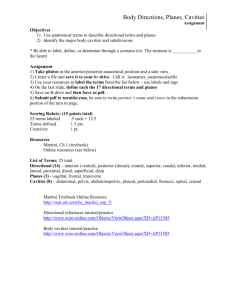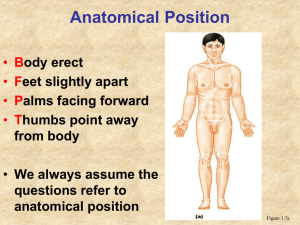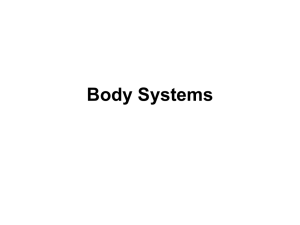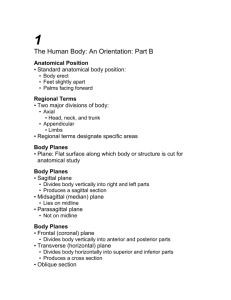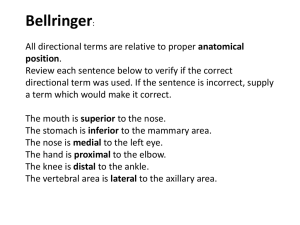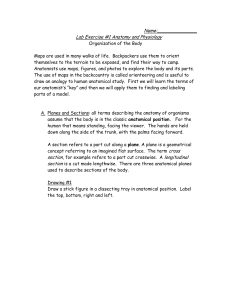Lab 1 - Crestwood Local Schools
advertisement
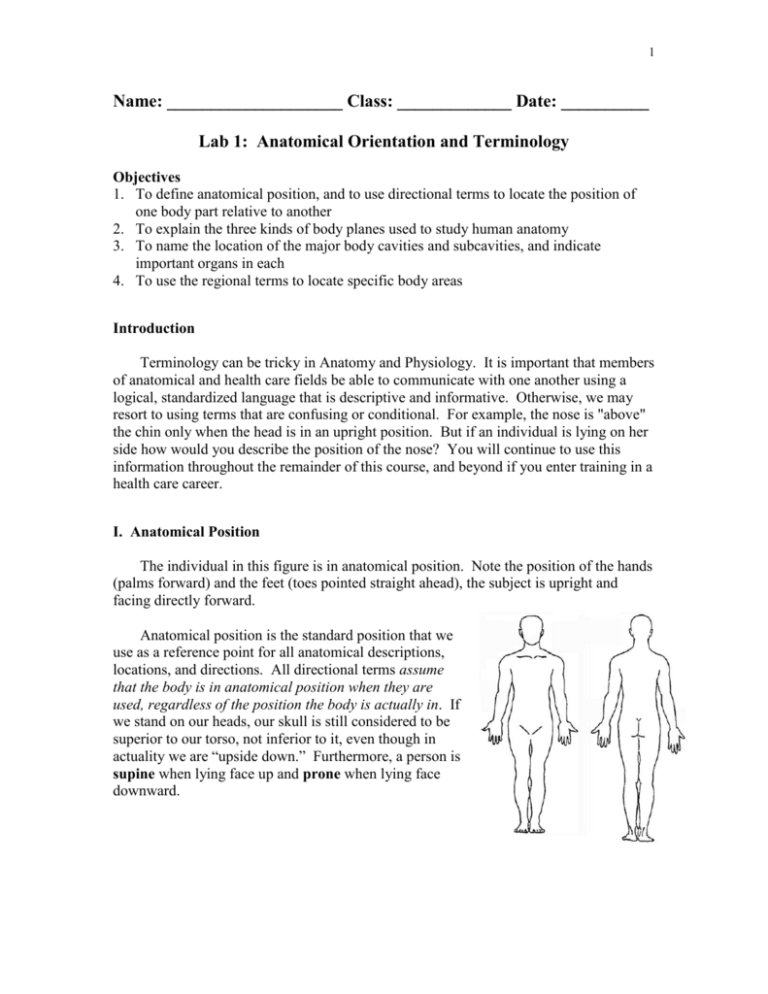
1 Name: ____________________ Class: _____________ Date: __________ Lab 1: Anatomical Orientation and Terminology Objectives 1. To define anatomical position, and to use directional terms to locate the position of one body part relative to another 2. To explain the three kinds of body planes used to study human anatomy 3. To name the location of the major body cavities and subcavities, and indicate important organs in each 4. To use the regional terms to locate specific body areas Introduction Terminology can be tricky in Anatomy and Physiology. It is important that members of anatomical and health care fields be able to communicate with one another using a logical, standardized language that is descriptive and informative. Otherwise, we may resort to using terms that are confusing or conditional. For example, the nose is "above" the chin only when the head is in an upright position. But if an individual is lying on her side how would you describe the position of the nose? You will continue to use this information throughout the remainder of this course, and beyond if you enter training in a health care career. I. Anatomical Position The individual in this figure is in anatomical position. Note the position of the hands (palms forward) and the feet (toes pointed straight ahead), the subject is upright and facing directly forward. Anatomical position is the standard position that we use as a reference point for all anatomical descriptions, locations, and directions. All directional terms assume that the body is in anatomical position when they are used, regardless of the position the body is actually in. If we stand on our heads, our skull is still considered to be superior to our torso, not inferior to it, even though in actuality we are “upside down.” Furthermore, a person is supine when lying face up and prone when lying face downward. 2 II. Directional Terminology Directional terms describe the location of a specific body part with respect to a different body part. Thus, different directional terms can be used to describe the position of a given body part depending on what we are comparing it to. For example, Crestwood High School can be described as north of Ravenna or south of Lake Erie. Both descriptions are accurate given the appropriate comparison. Use Table 1.1 to learn the following terms. You should be able to define and use these terms: anterior – posterior (ventral – dorsal) superior – inferior proximal – distal [usually used in reference to the point of attachment to the trunk] medial – intermediate – lateral superficial – deep supine - prone Note: The terms “Right” and “Left” refer to the subject’s right and left, not yours. Axial refers to the main part of the body (head, neck and torso). Appendicular refers to the parts that “hang off” the axial frame (arms and legs). Now practice the above directional terms by describing the following relationships: The trachea (windpipe) is to the esophagus (throat). Hair is to muscle. The thumb is to the ring finger. The heart is to the lungs. The ear is to the eye. The abdomen is to the thorax. Thigh muscles are to the femur (thigh bone). Skin is to skeletal muscles. The shoulder is to the elbow. The hand is to the elbow. The rib cage is to the upper arm. 3 III. Regional Terminology Refer to Body Landmarks Handout You should be able to identify the following anatomic regional terms. Make certain you understand how the different terms relate to one another. After identifying these surface landmarks, you should be able to locate them on lab models or your own body without looking at the textbook. Anatomical regional terms should be used and not common terms. A. Head (orbital, nasal, buccal, oral, occipital, cephalic, ) B. Neck (cervical) C. Trunk (sternal, thoracic, axillary, abdominal, umbilical, pelvic, coxal, inguinal, pubic, vertebral, scapular, lumbar, sacral, gluteal) D. Upper limb (acromial, brachial, antecubital, olecranal, carpal, digital) E. Lower limb (femoral, patellar, popliteal, crural, sural, tarsal, digital, calcaneal, plantar, fibular) 1. Label the regions on the adjacent diagram 2. Now practice the above surface landmark terms by matching the following descriptions with the correct choice of surface terminology: Cheek Back of knee Armpit Back of head Breastbone Hand Elbow Buttock Thumb Thorax 4 IV. Body Cavities Use Fig. 1.7 (supplemental) to identify the following body cavities and the organs they contain: Dorsal body cavities: - cranial cavity: contains - spinal cavity: contains Ventral body cavities: - thoracic cavity: contains - pericardial cavity: contains _______________________________ - *abdominal cavity: contains - *pelvic cavity: contains *these cavities are sometimes called the abdominopelvic cavity Now test your understanding of the body cavities by completing the exercise below. Match which body cavities would have to be opened for the listed surgical procedure (more than one choice may apply): (a) abdominopelvic (e) cranial (b) thoracic (f) pericardial (c) spinal (d) pleural cavity Removal of a diseased lobe of the lung Removal of a brain tumor Operation on the liver Triple bypass surgery on the heart Removal of a segment of the large intestine 5 V. Sectional Terminology In anatomy we often view a "slice", or plane, through a body. Identify the planes listed below. Keep in mind that, while planes through a whole body are easy to identify, those through unfamiliar organs may be more difficult. 1. Draw and label an example of each body plane on the adjacent figures. Sagittal planes: Midsagittal (medial sagittal) plane Frontal (coronal) plane Transverse (horizontal, cross-sectional) plane 2. How many mid-sagittal planes can divide the body?

